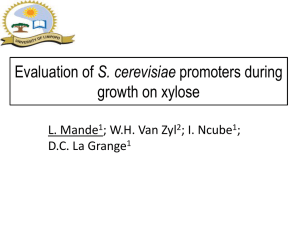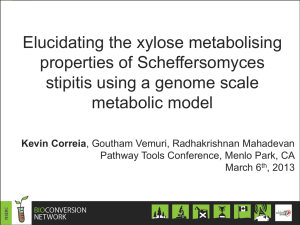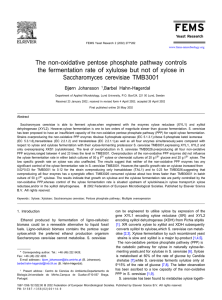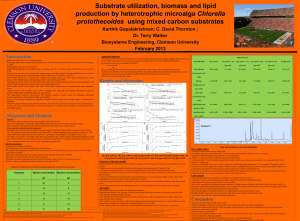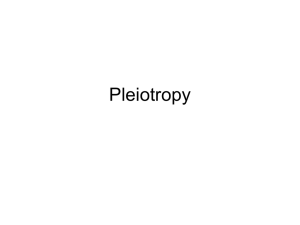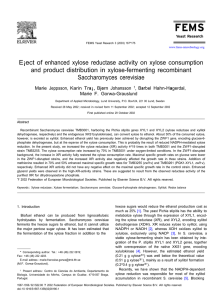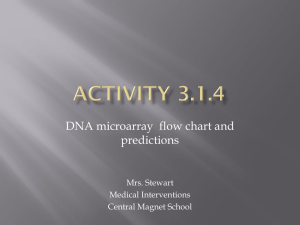Davis Weymann - Oregon State University
advertisement
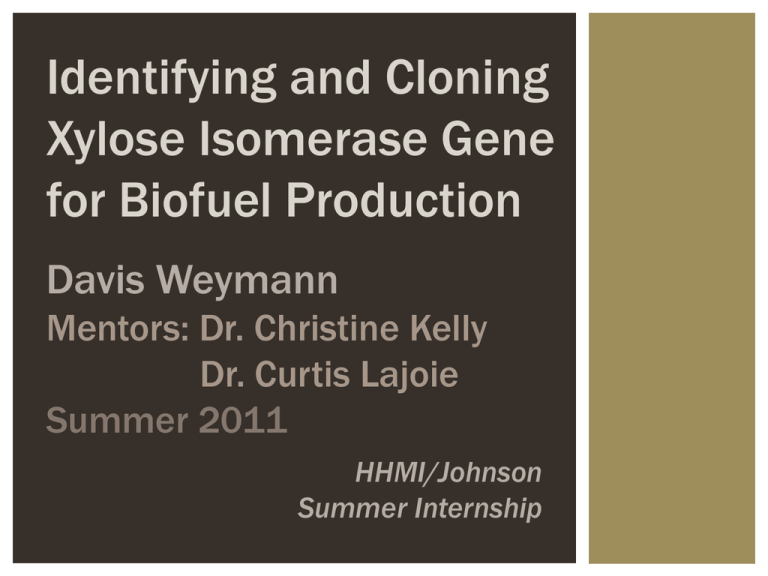
Identifying and Cloning Xylose Isomerase Gene for Biofuel Production Davis Weymann Mentors: Dr. Christine Kelly Dr. Curtis Lajoie Summer 2011 HHMI/Johnson Summer Internship BACKGROUND There is growing interest in alternatives to petroleum fuels Biofuels are promising, but require economical mass production methods before expanding Lignocellulosic biomass is cheap and widely available resource that does not share role as a food source Saccharomyces cerevisiae cannot break down all of the sugars in lignocellulosic biomass Fermentation Cellulose Ethanol (and CO2) XYLOSE Lignocellulose = Cellulose + hemicelulose + lignin 20-40% of lignocellulosic biomass is composed of hemicellulose Hemicellulose is easy to hydrolyze, but it yields mostly xylose. Xylose cannot be metabolized by S. cerevisiae Xylose isomerase (XI) converts xylose into xylulose, which then can be utilized by S. cerevisiae Attempts to engineer S. cerevisiae to produce XI have failed Common XI is active at high temperatures and pH’s. Not compatible with S. cerevisiae Xylose isomerase Xylose Xylulose GOAL A certain yeast (Y1) is thought to produce a xylose isomerase (XIy) that is compatible with ideal fermentation conditions of S. cerevisiae S. cerevisiae fermentation: pH ~5 35°C XI from Y1 (XIy): pH 4.5 37°C Ultimate goal: genetically engineer an organism to mass-produce XIy, which will then be used in fermentation with S. cerevisiae Challenge: The location of the XIy gene on Y1’s genome is unknown Project goal: Identify and isolate the XIy gene FERMENTATION DIAGRAM Current method Goal Heat exchange xylose → Xylose & EtOH Biomass hydrolysis and glucose fermentation → ↑ Ion exchange Solid/liquid separation Solids to energy recovery ↑ NH4OH injector to raise pH Yeast, enzymes, pre-treated biomass pH 7.5, 55°C Xylose fermenter pH 5, 30°C Contains immobilized XI ← xylulose ← Isomerization reactor Ethanol to distillation Yeast, enzymes, pre-treated biomass Biomass hydrolysis and glucose & xylose fermentation (contains immobilized compatible XI) pH 5, 30°C Ethanol to distillation → Solid/liquid separation Solids to energy recovery Technology by Trillium FiberFuels, Inc. PCR (INITIAL METHOD) P.C.R.= Polymerase Chain Reaction Used to duplicate and isolate a specific genetic sequence Two other eukaryotic XIs are known, and XIy was suspected to be similar to them Search Y1’s genome for sequences similar to known XI genes Degenerate primers attach to sites that match target with discrepancies Degenerate primers matching known XI genes will target sequences that are similar (don’t need to be identical) PCR RESULTS We know the expected size of the copied sequences because they matched known XI genes None of the copied gene sequences were of the expected length The degenerate primers copied other sequences, but not the ones expected No obvious XI gene matches were copied by the degenerate primers The blue arrow represents the size that was hypothesized. There are no bands at that location. GENOMIC SEQUENCE Not any great matches in entire genome pXI1: Codes for a protein (probably an endonuclease) with similar 3D structure as XI pXI2: Codes for a phosphorylated sugar isomerase with the expected molecular weight Still is the question of if Y1 actually produces XI The strain used in original study was lost It has been difficult to detect XI activity from Y1 FUNCTIONAL SEARCH WITH VECTORS Testing function of a gene by isolating then inserting it into an organism and observing if it makes the desired protein Insert the putative XI genes into E. coli and mutant Hansenula p. using a vector plasmid If the lysate from the transformed E. coli has XI activity (plasmid coded for inter-cellular proteins), it might have accepted the XIy gene. Bacteria can’t always make eukaryotic proteins, however. If the transformed mutant Hansenula p. can grow on xylose, either the XIy gene or xylitol gene was probably accepted Hansenula p. plates: Control: No colonies No colonies: no XIy gene Some colonies: XIy gene might be present PLASMID VECTORS Target Sequence Genome Culture the E. coli w/ plasmids Plasmid Insert plasmids into Hansenula p. Can it ferment xylsose? Cut plasmid and genome w/ enzymes Insert the sequence into plasmid Extract the plasmids Heat-shock plasmid into E. coli Mutant Hansenula p. can’t grow on xylose PLASMID INSERTION RESULTS E. coli cells showed significantly increased activity Activity was over an unreasonably long time, however First attempt to insert into yeast yielded no activity XI activity of putative genes in E. coli Xylulose Produced (g/L) 2.50 2.00 1.50 Control Put1 Put2.1 Put2.2 1.00 0.50 0.00 0 20 40 60 Time (hours) 80 100 120 CONCLUSION The gene for XIy has not yet been identified The results of the ongoing tests will determine if the line of research is continued Does out strain of Y1 indeed contain the gene for the supposed XIy? Maybe BIBLIOGRAPHY Sources: Christine, K. Development of a Fermentation Compatible Xylose Isomerase Enzyme. 2010. Trillium FiberFuels, Inc. Christine, K. Sungrant Proposal. 2010. Trillium FiberFuels, Inc. Wikipedia (general reference only) Image Credits (In order of appearance) http://www.uq.edu.au/_School_Science_Lessons/16.3.1.6ach.GIF http://upload.wikimedia.org/wikipedia/commons/thumb/e/e8/Ethanol structure.svg/529px-Ethanol-structure.svg.png http://upload.wikimedia.org/wikipedia/commons/6/6a/Xylose.png http://upload.wikimedia.org/wikipedia/commons/archive/b/b9/201005101646 14!Xylulose.png http://www.alvinziegler.com/gridlock/wp -content/uploads/2009/12/Genome white.jpg http://schoolworkhelper.net/wp-content/uploads/2011/06/PCR1.jpg http://blog-images.microscopesblog.com/uploaded_images/pipet -701236.jpg http://www.usascientific.com/productimages/16155500_300.jpg Christine, K. Development of a Fermentation Compatible Xylose Isomerase Enzyme. 2010. Trillium FiberFuels, Inc. Weymann, Davis. July 2011. ACKNOWLEDGEMENTS Dr. Christine Kelly Dr. Curtis Lajoie Pete and Rosaline Johnson Dr. “Skip” Rochefort Howard Hughes Medical Institute (HHMI) Dr. Kevin Ahern Trillium FiberFuels, Inc.
